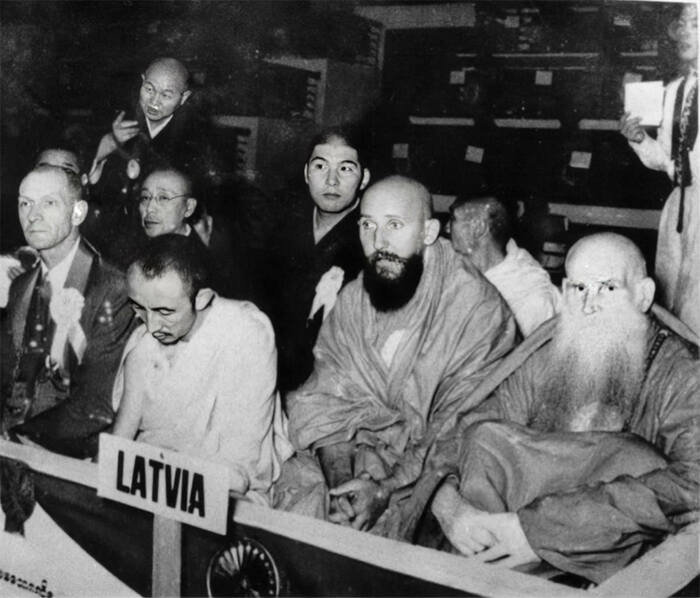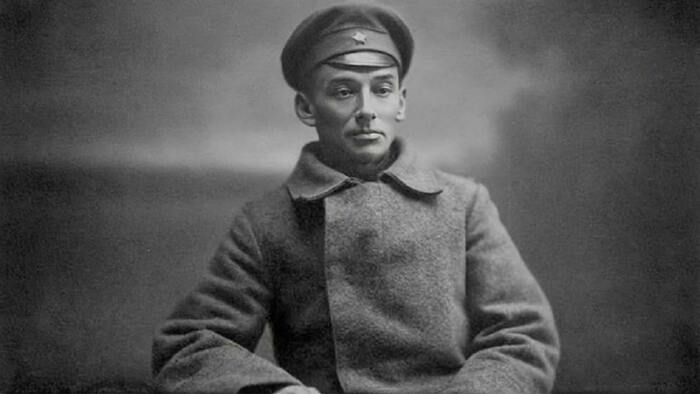The Founding of Mongolian and Tibetan Buddhist Academic Studies
The earliest translations into Russian from Tibetan were made toward the end of the 17th century by Pavel Kulvinsky from the Russian Ministry of External Affairs. He had learned Tibetan during his visits to the Oirat Mongols in Central Asia. Later, during the early 18th century, Tibetan artefacts and Buddhist texts found in Ablainkit and other Oirat monasteries on the territory of the Russian Empire were brought to St. Petersburg. These were the first items to arouse the interest of European scholars in Tibeto-Mongolian culture; however, regular academic study of Buddhism began in Russia only in the 19th century.
In 1818, the Asiatic Museum was founded in St. Petersburg under the Imperial Academy of Sciences. The museum became an extensive depository of Asian manuscripts, including Buddhist ones in various languages. Among its most prominent early scholars was Isaac Jacob Schmidt (1779–1847). With his publication of grammars and dictionaries of Mongolian and Tibetan, he helped establish Mongolian and Tibetan studies in the Russian Empire. In 1833, the Department of Mongolian was established at the Kazan Imperial University. Later in the 1830s, the Center of Oriental Studies was founded at the same university and, in 1854, was transferred to St. Petersburg Imperial University.
In 1927, the famed Indologist Fyodor Ippolitovich Stcherbatsky (1866–1942) founded the Institute of Buddhist Culture in Leningrad (renamed from St. Petersburg in 1924, after having been called Petrograd from 1914–1924). The Institute was established within what was now called the Academy of Sciences of the USSR. In 1930, this Institute was fused with the Asiatic Museum and its Board of Orientalists and Turkology Group to form the Institute of Oriental Studies of the Academy of Sciences of the USSR.
In 1980, old Buryat lamas told the author that all of Stcherbatsky’s disciples who came to work in Buryatia, with the exception of the Tibetologist Andrei Ivanovich Vostrikov (1904–1937), were in fact Buddhists. In 1937, almost all the staff of the Institute of Oriental Studies, including Vostrikov, were arrested and shot, although Stcherbatsky himself was spared.
Kārlis Tennisons
Тhe first non-ethnic Buddhist known to us in the Russian Empire was the Estonian/Latvian subject of the Russian Empire, Kārlis August Mikhailovich Tennisons, aka Karl Tõnisson, or Brother Vahindra (1883–1962). He also appears to have been one of the world’s first non-ethnic Buddhist monk, if the report that he took monastic vows in the Barguzin Datsan of Buryatia in 1900 can be trusted. “Datsan” (Tib. grva-tshang) is the Buryat term for a monastery.
Tennisons was a controversial figure, around whom many myths developed. He himself changed many facts about his life several times. Tennisons’ Latvian disciple, Friedrich V. Lustig (1912–1989), in his unpublished biography of Tennisons, The Mahatma of Baltic: The Remarkable Life of the Most Rev. Kārlis A. M. Tennisons, The Buddhist Archbishop of Latvia, embellished his teacher’s life even more. Tennisons, however, was in fact enlisted on the staff of the newly built St. Petersburg Buddhist Temple, completed in 1915. When Dorzhiev left for Tibet in 1917, where he stayed until 1920, he left Tennisons in St. Petersburg as the abbot of the temple. Tennisons was the only person who could stay there during that period.
After leaving St. Petersburg, Tennisons went to Latvia, which became an independent state in 1919 until it was incorporated into the USSR in 1940. In 1924, Tennisons organized the first Buddhist community in Riga. At the end of 1930, he left with Lustig and traveled first to Europe and then to Asia. They stayed for some time in China, then in Thailand. In 1949, they moved to Burma, where Tennisons died in 1962.

The prestigious Buddhist magazine The International Buddhist News Forum (1962) caused a stir with the report that Tennisons’ deceased body remained fresh for days despite the hot weather. Another magazine, The Nation (Rangoon, 1962) wrote that His Holiness the Fourteenth Dalai Lama had expressed condolences to Lustig on this occasion. As with many other aspects, many reports on the life of Tennisons are questionable.
The St. Petersburg Temple
The St. Petersburg temple was built under the supervision of the Buryat monk Agvan Dorzhiev (1853–1938), a Master Debate Partner of the Thirteenth Dalai Lama, with the permission of Tsar Nikolaus II (1868–1918) and financing provided by the Thirteenth Dalai Lama (1876–1933) and the Buryat and Kalmyk Buddhist communities. It was completed in 1915. Some stained-glass windows for the temple were made by the artist Nikolai Konstantinovich Roerich (1874–1947), who developed the theosophical teaching of Agni Yoga, in which elements of Buddhism were incorporated.
The temple was ransacked in the absence of monks in 1919 – all the books, archives and images disappeared – but after protests by Dorzhiev, it was repaired to some extent. Meanwhile Dorzhiev was arrested and sentenced to death by the Cheka (the All-Russian Extraordinary Commission), the Soviet secret police organization from 1917–1922. His sentence was commuted, however, at the intervention of the Orientalist scholars in Petrograd, and Dorzhiev was released, and he continued his efforts to oppose repressions against Buddhists. His efforts were successful to some extent as he was needed by the Soviets as a mediator in their secret contacts with the Thirteenth Dalai Lama. The USSR was interested in reaching British-governed India via Tibet, but when the Dalai Lama finally refused to cooperate with the Soviets, the game was over and Dorzhiev was allowed to retreat to Buryatia. He was arrested again in 1938 by the NKVD (the People’s Commissariat of Internal Affairs, the Soviet secret police organization from 1934–1943) and subsequently died in a prison hospital.
The St. Petersburg Temple was repaired in 1922 and gave local people of different nationalities a possibility to join Buddhist practices. There is, for example, a certificate signed by Dorzhiev сonfirming the taking of the monastic vows by a certain 18-year-old Mikhail Ivanovich Popov (Lefler) in 1922.
The temple underwent a major restoration in 1926. It held its last Buddhist ritual in 1933 in honor of the recently deceased Thirteenth Dalai Lama. In 1935, the NKVD arrested most of the monks at the temple and, in 1937, most were executed.
The Kalachakra Study Group within the OGPU
In the 1920s, some mystical ideas, supposedly derived from Buddhism, penetrated even into the OGPU. The OGPU, the Joint State Political Directorate, was the intelligence service and secret police of the USSR from 1923–1934, the successor of the Cheka and predecessor of the NKVD and the KGB. The main OGPU officer involved with these mystical ideas was Gleb Ivanovich Bokii (1879–1937), the head of the OGPU’s Special Department in charge of encryption methods and the security of internal communications.

The parapsychologist Aleksandr V. Barchenko, who collaborated with Bokii and had been introduced to Buddhism in Mongolia when visiting it for a few months, created in this Special Department a circle for the study of Kalachakra, one of the most complex Vajrayana systems. The members of this circle sought to merge the Kalachakra tantra methods with communism in order to engineer perfect communist human beings. They even planned an expedition to Central Asia and Tibet to find the so-called “wisdom of Shambhala.” In 1937, the members of this Kalachakra study circle, including Bokii, were arrested and executed. After this, we don’t have more information about non-ethnic Buddhism in the USSR until the 1960s.
Anna Akhmatova
The great Russian poetess Anna Andreyevna Gorenko (1889–1966), better known as Anna Akhmatova, also had an interest in Buddhism. As a translator of some of the works of Rabindranath Tagore (1861–1941), Akhmatova mentioned in her notebooks (p. 464) that she was particularly distressed after the death of Tagore and even more so with the death of Jawaharlal Nehru (1889–1964). She wrote that the approach to Buddhism by which she had been living lately was to recite the dharani, the devotional Sanskrit formula, of the goddess Chunda, which she transcribed in Russian as “jale jule dzhunda svaha brum.”
As far as the author is aware, besides individuals such as Akhmatova, whole groups of people trying to study and practice Buddhism began to appear only in the 1960s. This was probably due to the de-Stalinization policies of Nikita Sergeyevich Khrushchev (1894–1971).